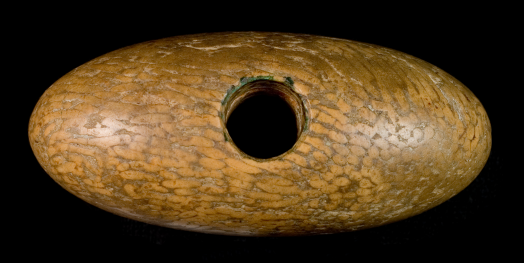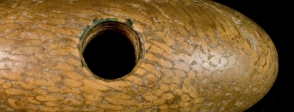
Where it was found
Bush Barrow is a round barrow, an artificial mound constructed over one or more burials. A large number of barrows were constructed on the summit of ridges overlooking Stonehenge. Bush Barrow is one of fifty in the Normanton Down barrow cemetery. Round barrows focus on the burial of an individual and so mark a change from the long barrows of the earlier Stone Age, which were usually the burial place of a whole community.
The objects in the burial
The mace-head was found on the right side of the body. It is made of a fossilised sponge from Devon and was originally mounted on a wooden handle that was decorated with zigzag bone mounts and a small sheet gold lozenge. The mace to which the head belonged was a weapon and probably also a ceremonial object.
These were not the only high status objects from the burial. A superbly decorated larger sheet gold lozenge was sewn on to the man’s clothes over his chest and he also had a belt hook of sheet gold. He was buried with two very long flat bronze daggers and a flat axe head. Both daggers came all the way from Brittany in France and the wooden hilt of one of them was decorated with as many as 140,000 tiny gold rivets. Another dagger was found on the edge of the grave, but was already 200 to 300 years old. Perhaps this was a family heirloom or it may have come from an earlier burial missed by the excavators.
Power and control
The burial under Bush Barrow is the most spectacular of all Early Bronze Age burials. It dates to after the main phases of construction at Stonehenge, but at a time when the smaller bluestones from Wales were being moved into a new arrangement within Stonehenge. The man was clearly someone of high status, probably a chieftain or leader, and possibly someone descended from whoever directed the construction of Stonehenge and the surrounding ritual landscape.
This man may have derived his power from controlling networks of trade and gift-exchange. The mace-head was made from a most unusual stone, which came from Devon, close to the copper and tin mines of Cornwall. The bronze objects perhaps came from fellow leaders in Brittany, possibly made from Cornish or Welsh copper that was also traded through the Wiltshire region. The gold may have come from Ireland. The zigzag mounts on the mace handle are similar to ornaments found in Greece and Spain around the same time, suggesting far-reaching networks of influence.
There is evidence that women could also wield power in this period. At Golden Barrow a few miles from Stonehenge is the burial of a woman with a gold plaque, gold pendant and beads and a magnificent amber necklace, probably made in Denmark. The magnificent gold cape from Mold in north Wales may well have been worn by a woman.
More information
Bush Barrow burial
A useful overview of the Bush Barrow burial from Wiltshire Museum.
http://www.wiltshiremuseum.org.uk/galleries/index.php?Action=3&obID=89&prevID=9
Video about the burial
A four-minute video of TV archaeologist Phil Harding discussing the significance of the burial.
https://www.youtube.com/watch?v=MNY6UsuC7KA
Introduction to Golden Barrow
Information on Golden Barrow, the burial of a wealthy woman.
http://www.wiltshiremuseum.org.uk/galleries/index.php?Action=3&obID=101&prevID=9
Video about another burial
A three-minute video of TV archaeologist Phil Harding talking about the burial of a Bronze Age shaman or priest.
http://youtu.be/egqPuD_dMuI?list=UU6-eOaANipxFdbBxia1gvnw
Mold gold cape on the radio
The Mold gold cape is included in A History of the World in 100 Objects. Listen to the programme or read the transcript.
http://www.bbc.co.uk/ahistoryoftheworld/objects/okZT5JiCTn6lYFR0Gs9Tbg
Introduction to Stonehenge
This section of the English Heritage website is an essential introduction to Stonehenge.
http://www.english-heritage.org.uk/daysout/properties/stonehenge/discover/
Stonehenge: history and research
A more detailed background to Stonehenge is available here.
http://www.english-heritage.org.uk/daysout/properties/stonehenge/history-and-research/
More information
-
Bush Barrow burial
A useful overview of the Bush Barrow burial from Wiltshire Museum.
Source: wiltshiremuseum.org.uk
-
Video about the burial
A four-minute video of TV archaeologist Phil Harding discussing the significance of the burial.
Source: youtube.com
-
Introduction to Golden Barrow
Information on Golden Barrow, the burial of a wealthy woman.
Source: wiltshiremuseum.org.uk
-
Video about another burial
A three-minute video of TV archaeologist Phil Harding talking about the burial of a Bronze Age shaman or priest.
Source: youtube.com
-
Mold gold cape on the radio
The Mold gold cape is included in A History of the World in 100 Objects. Listen to the programme or read the transcript.
Source: bbc.co.uk
-
Introduction to Stonehenge
This section of the English Heritage website is an essential introduction to Stonehenge.
Source: english-heritage.org.uk
-
Stonehenge: history and research
A more detailed background to Stonehenge is available here.
Source: english-heritage.org.uk


